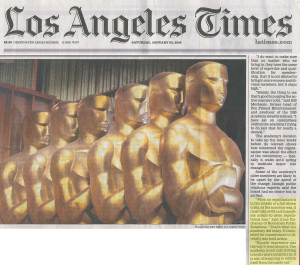The big news on the East Coast last week was the blizzard. But at Buchanan Public Relations, we experienced another flurry of activity of a different nature – one that reminded me why we invest so much time in helping clients prepare for a media interview.
When it  was all over, I found myself quoted in a front page article in the Los Angeles Times.
was all over, I found myself quoted in a front page article in the Los Angeles Times.
But the process of getting from “Initial Media Inquiry” to “Published” was a circuitous one, full of good learning about preparation and reminders about the unpredictability of news.
Last Friday afternoon, just hours from the arrival of Winter Storm Jonas, I received a phone message from a reporter at the Los Angeles Times. She was working on a story about the Oscars diversity crisis confronting the Academy of Motion Picture Arts and Sciences. Would I be willing to share my thoughts on what the Academy should do?
I must confess, my first thought was mild dismay: I didn’t have time for this, nor did I feel particularly well qualified for the assignment.
But here’s Tip # 1 we share in Media Training: [inlinetweet prefix=”null” tweeter=”null” suffix=”null”]You’ve got to make media relations a priority if you want to succeed at it. [/inlinetweet]Reporters will call at inconvenient times and are often on deadline. Make the time to respond – quickly, before they locate another source.
I called the reporter back. She was happy to hear from me and launched right into questions. Which is where I put Tip # 2 into practice. I asked if I could call her back in 20 minutes, if her deadline permitted. And, could she give me a sense of what she wanted from me so I could be as thoughtful as possible in responding?
(Tip # 2: Whenever possible, buy yourself a few minutes to ponder the question(s) and think about your response. Develop your Key Messages. Do your homework before the interview.)
When I called her back, our entire office had crowdsourced ideas and checked recent news coverage.
In my interview with her, I was able to employ the Key Messages we had developed. In an effort to be memorable, I advised the Academy to borrow a page from the business world’s playbook: Assemble a diverse task force to quickly make concrete recommendations to the Academy. The Academy was in crisis, I said, and it needed to take swift action, not just talk about the problem.
(During the interview, I suddenly remembered another tip we share with clients: Stand up when you’re giving a phone interview. It adds energy to your voice and literally helps you think on your feet. Up I lunged!)
All good. Reporter was happy. I was exhausted but pleased. We hung up and I returned to client work.
Thirty minutes later, another truism of Media Training manifested itself: Be prepared for the news to change – and for “your” story to get bumped.
The reporter emailed, apologizing that the original story had just been supplanted by the Academy’s announcement of massive changes: It would double female and minority membership in the Academy by 2020 and set “term limits” on members’ ability to vote.
But, the reporter wrote, she would still be interested in my take on the moves announced by Academy president Cheryl Boone Isaacs.
It was impressive stuff.
I sat down to type my response. (Cue up Tip # 5: Being “interviewed” by email actually gives you a lot of control. But – Tip # 6 – make sure it’s compelling content. You typically get one shot at a written response.)
I considered the reporter’s appreciation of my earlier comments about the Academy’s crisis. I reflected on my original Key Message about action – not just talk – being needed. And I thought about what we counsel clients: Don’t just say something is good or bad; tell readers why it’s that way. Interpret the meaning behind the announcement.
A quick paragraph, summarizing my thoughts, was emailed to the reporter.
Late that night, after we had battened down the hatches and were listening to the storm howl outside, I checked my phone one last time. And there it was. An article in the Los Angeles Times about the Academy’s moves. (The next day, we learned it was on page 1 of the paper.) Near the end of the article were these two paragraphs.
Some of the academy’s older members are likely to be upset by the speed of the change, though public relations experts said the board had no choice but to act fast.
“When an organization is in the middle of a full-blown crisis, as the academy was, it must take swift and immediate action to stem reputational loss,” said Anne Buchanan of Buchanan Public Relations. “That’s what the academy did today. It translated its commitment to diversity into bold action. Equally impressive was the way it went about it. The academy is not only striving to invite more outsiders in; it is also attempting to reform itself from the inside out.”
I went to bed that night with newfound appreciation for clients who are new to working with the media – along with a fresh perspective on why media training is so crucial.
Anne – bravo! Always good to remember that the cobbler needs to tune up his own shoes every now and then and preparation is key. Very impressive work. Cheers, David
It is sometimes difficult to “practice what we preach” when we find ourselves on the other end of the reporter’s questions. Well-done and well-said!